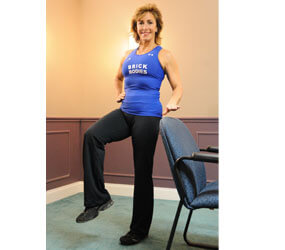By Lynne Brick
Review contributor
The aging process happens regardless of our genetics, regardless of our activity level and regardless of our eating habits. While no one can stop the chronological clock, you can, however, slow down the aging process and improve your quality of life.
How? Move your body! Does this sound too good to be true? Movement’s medicinal qualities are truly magical. It’s never too late to add more movement into your life. Here are some moves that can improve your strength, prevent debilitating diseases and illness as well as help to add years to your life and life to your years.
1. Get up off your seat and get up on your feet! The surgeon general recommends that you do 15 to 30 minutes of non-stop cardiovascular activity daily. Why? When you sit to watch television, play cards or read, you may be more at risk of developing cancer as well as other diseases. You should move a little every single hour. Movement helps your organs function more efficiently, helps your blood circulate throughout your mind and body exercising your heart muscle plus movement helps prevent cancer and other diseases. Walking is one of the best ways to exercise your heart. Here are a few ways you can add more steps into your daily life:
• Walk while you talk on the phone.
• Park farther away from the front door.
• Take the steps instead of the elevator.
Measure the number of steps you take daily with a pedometer. Make 10,000 steps your daily goal.
2. Strength train. Did you know that you lose a half a pound of muscle every year after the age of 30, just from the aging process? Strength training simply means you make your muscles work harder than they normally do. Even the American Heart Association recommends you strength train one to two times per week. Why? The more muscle mass you have, the easier it is to ambulate, to balance and prevent accidental falls and efficiently lose weight. A pound of fat burns two calories per day. A pound of muscle burns 45 calories per day.
Here are a few ways to gain strength training benefits:
• Desk push-aways. Place your hands under shoulders against a sturdy desk, table or kitchen counter. Place your feet away so your body is a straight line from your head to your heels. Bend your elbows, lowering your chest closer to the desk, table or counter. Straighten your elbows to your starting position. Repeat 10 to 20 times.
• Flamingo stand. Stand close to a sturdy chair back or counter top. Lift one foot off the floor. Hold for 30 to 60 seconds. Repeat four to six times. If balance is an issue, hold onto the chair. Reverse to the other side. Advanced: close your eyes as you hold your balance!
• Hold the Plank. Place your elbows on the floor, under your shoulders as you lie prone. Squeeze your shoulder blades together, hold your belly tight as you raise up onto your knees. Keep your body in a straight line from your head to your knees. Hold for 30 to 60 seconds. Repeat five to six times. Advanced: raise up onto your toes or raise up onto your hands and toes.
3. Flexibility training. Supple muscles and joints help you enjoy your daily activities, pain free. Flexibility refers to range of motion around a joint. The greater your flexibility, the less likely you may experience joint pain, back pain or ambulatory issues. How long should you hold a stretch? Hold each stretch for three to five seconds, relax, then repeat nine more times.
Here are a few ways to improve your flexibility:
• Butterfly stretch. Place your hands behind your head. Open your elbows as wide as you can to stretch your chest muscles.
• Calf stretch. After you walk, place your hands against a wall. Now, place one foot in front of the other, hip width apart. Bend your front knee. Keep both feet flat on the floor. Reverse to the other side.
• Reach stretch. Lie on your back. Reach your arms overhead and your legs as long as possible.
You don’t have to do this alone! Find a friend to walk with or to train with. Or try a supervised beginner exercise program such as Brick Bodies’ First Step Program.
As someone once said, “Early in life we give up our health to gain our wealth. Later in life, we give up our wealth to regain our health.” It’s never too late to make healthy choices.
Lynne Brick is a parishioner of Church of the Nativity in Timonium.
Resources and suggested reading:
Crowley, Chris and Lodge, Henry, MD. “Younger Next Year,”
www.mercola.com
Nelson, Dr. Miriam. “Strong Women Stay Young”
Peeke, Dr. Pamela. “Fight Fat after Forty”
Pilzer, Paul. “The New Wellness Revolution”
www.health.gov/paguidelines
USA Today. “Get up! Sitting linked to cancers” Nov. 3, 2011, Page 3A


